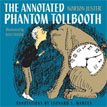 
|
Norton Juster’s classic children’s book The Phantom Tollbooth is back better than ever in a new incarnation. I have fond memories of having read and enjoyed this fantasy novel of young Milo and his adventures in Dictionopolis.
The story is timeless, as fresh today as it was when it first appeared over 50 years ago. The illustrations by Jules Feiffer also bring back many memories, and they are as cool and original as I thought they were when I first read this book.
The Annotated Phantom Tollbooth contains loads of added information that may not necessarily appeal to younger readers but which older readers who are now parents and want to learn more about the author and illustrator of the novel will want to read. Leonard Marcus is extremely knowledgeable and provides fans of the original book with biographical information about Juster and Feiffer’s formative years. contains loads of added information that may not necessarily appeal to younger readers but which older readers who are now parents and want to learn more about the author and illustrator of the novel will want to read. Leonard Marcus is extremely knowledgeable and provides fans of the original book with biographical information about Juster and Feiffer’s formative years.
He includes photos of them when they were younger, accounts of how Juster got the idea to write the novel, and the many pop and cultural references that Juster drew on, such as the Marx Brothers’ movie Animal Crackers. He also points out parallels with The Wizard of Oz.
What has made The Phantom Tollbooth into a classic? The story of Milo, himself, and the memorable watchdog who has an actual watch for a body stand out the most for me. The towns Milo journeys to and their odd inhabitants are also visions that have lived in my memory since my childhood years: the town of Expectations, “which sadly many journeys never reach beyond”; the Islands of Conclusions; and the demons of the Mountains of Ignorance, among the other places Milo travels.
As you can tell by the names of the places Milo journeys to, if you hadn’t already guessed (or if you haven’t already read the book previously), Juster intended that, in addition to an entertaining fantasy, his novel would present a philosophical message, or moral. The Phantom Tollbooth does this extraordinarily well without ever getting too preachy.
In this respect, it reminds me somewhat of a novel-length fable, and Juster can be considered to be a modern-day Aesop. It is also like an extended myth, but one set in a peculiar Alice in Wonderland type of alternate universe.
Milo’s efforts at making his way towards Dictionoplis and adventures in the city are as quirky and humorous today as ever. While the annotated version might not add a great deal that kids might be interested in now, they will likely want to re-read it when they’re older, and will be glad to have this edition to learn more about the book they loved reading so much as a child. This was the case with me, at any rate.
For parents wanting to learn more about the children’s classic they loved as children or for a child searching for a timeless beloved classic to read and cherish, I heartily recommend The Annotated Phantom Tollbooth . Leonard Marcus documents the origins of this famous work of literature through his research, preserving for all time the history behind The Phantom Tollbooth. . Leonard Marcus documents the origins of this famous work of literature through his research, preserving for all time the history behind The Phantom Tollbooth.
|







|